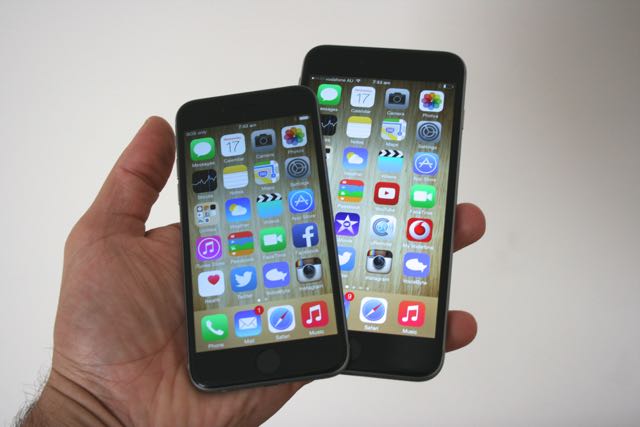Tech Guide’s complete reviews of the iPhone 6 and iPhone 6 Plus
 Apple has raised the bar in all areas with the iPhone 6 and iPhone 6 Plus – to create the best smartphones the company has ever produced by far.
Apple has raised the bar in all areas with the iPhone 6 and iPhone 6 Plus – to create the best smartphones the company has ever produced by far.
Tech Guide has been using the new iPhones for a week and they take the device’s already high standards of design, features and performance to all-new heights.
Apple has lagged behind the field in one area – screen size – with some users lured away to other brands by their larger crisp displays.
But with the iPhone 6 (4.7-inch) and iPhone 6 Plus (5.5-inch), Apple has delivered the bigger screens customers want.
DESIGN
Apple has once again knocked it out of the park with the iPhone 6 and iPhone 6 Plus design.
Exuding Apple’s signature build quality, the products have smooth consistent curved edges and rounded corners. It’s quite a departure from the angular feel of the iPhone 5S.
Even the edges of the screen curve down at the edges to seamlessly flow into the aluminium unibody so it maintains the same shape front and back.


And boy, are they thin! That was a real surprise when we first held the new iPhones in our hands. The iPhone 6 is a slender 6.9mm thick while the iPhone 6 Plus a svelte 7.1mm.
The top edge of both the iPhone 6 and iPhone 6 Plus is undisturbed. The lock key – located in this position on the iPhone 5S and every other iPhone that came before it – is now on the right side above the SIM card tray.
There is a reason for this that we’ll get into later in this review.
Down the left edge you’ll find the silent switch just above new thinner and longer volume up and down keys.


Along the bottom are the 3.5mm headphone jack, the Lightning connector and the speaker.
Flip iPhone 6 and iPhone 6 Plus over and you’ll find a smooth aluminium back panel with stripes near the top and bottom edges to allow for clear transmissions to and from the device’s 4G, Bluetooth and wi-fi radios.
In the top section is the camera and dual-flash. The camera’s lens actually protrudes a millimetre or two out from the iPhone’s body.
This means if you place the iPhone down on a table it is resting on the lens. It’s a good thing it’s covered in sapphire glass – the second hardest transparent material behind diamond.

The home button/Touch ID fingerprint reader below the screen is also covered in a circular piece of sapphire glass.
DISPLAY
The most noticeable features of the iPhone 6 and iPhone 6 Plus are the larger screens – 4.7-inch and 5.5-inch respectively.
And many customers will be welcoming them with open arms after seeing the screens of other smartphones grow rapidly around them.
Apple’s justification for sticking with a smaller screen was the ability to still easily use the iPhone with one-hand. Something you can still do with the addition and movement of a couple of features – but more on that a littler later.

The larger screens are Retina HD Display with a pixel density of 326ppi (pixels per inch) for the iPhone 6 (the same as iPhone 5S) and 401ppi for the larger iPhone 6 Plus.
The resolutions of the iPhone 6 and iPhone 6 Plus are 1334 x 750 and 1920 x 1080 respectively with the latter packing the same number of pixels into its 5.5-inch screen as the large TV in your lounge room.
There’s higher contrast for blacker blacks and whiter whites plus naturally warm and vibrant colours
The result is a bright sharp screen with images, videos and text rendered beautifully.
But looking at a larger screen iPhone took some getting used to. It gave us a sense of luxury with the knowledge that our favourite apps, pictures, videos and websites can now be enjoyed on a much bigger canvas.
And the good news is that all of the apps scaled to the larger screen sizes and remained sharp and clear.
SCREEN SIZE
The iPhone 6 and iPhone 6 Plus are certainly not the first large screen smartphones. This was an area previously dominated by Android devices.
But Apple’s decision to release not one but two different size iPhones means the company is now competing in new parts of the expanding market.
The iPhone 6 is now in the same ballpark size-wise as the Samsung Galaxy S5, the HTC One M8 and the Sony Xperia Z2 and Z3.
The even larger iPhone 6 Plus is now in the same category or larger devices like the Samsung Galaxy Note 3, the HTC Desire 816 and the recently released LG G3.

The biggest decision for anyone interested in buying the new iPhone will be deciding which model to go for.
Coming from the iPhone 5 or iPhone 5S, the move to the iPhone 6 and iPhone 6 Plus is quite a leap.
The iPhone 6 offers a good middle ground for users who want a bigger screen but are not prepared to handle the much larger iPhone 6 Plus.
For our money we can’t go past the iPhone 6 Plus and that larger 5.5-inch screen. But it’s not for everyone.
Hold the iPhone 6 Plus in your hand and you’ll appreciate just how big it is. It’s quite a commitment to marry yourself to a device of this size. Can you fit in your pocket? Can I carry this around all the time?
If you have doubts about these questions then perhaps the 4.7-inch iPhone 6 is the device for you.

But if you have the same “go big or go home” attitude like us, then you’ll welcome the 5.5-inch iPhone 6 Plus with open arms.
No matter which one you choose Apple still wants you to be able to use them with one hands.
Remember we mentioned the lock key being relocated from the top to the side of both new iPhones? This makes it easier to lock the device singlehandedly instead of having to stretch your finger all the way to the top of the device.
Another new feature also promotes one-handed use – Reachability.
Simply double touch the home key (not double tap – that will activate another feature) you’ll see the top of the screen brought down to the lower half of the screen so you can reach it with your thumb whether it’s the apps on the home screen or a web page you happen to be browsing.

You can also swipe left and right with your thumb to go back and forward on the web pages.
iPhone 6 Plus also has landscape view on the home screen where you can hold the screen sideways and watch the icons adjust. This also gives you an iPad-like experience with your mail, messages and with the weather app.
On either iPhone you can also choose Standard or Zoomed view for your icons.
If you opt for Zoomed view on the iPhone 6 Plus, you won’t be able to use Landscape view on the home screen.
CAMERA
The rear iSight camera on the iPhone is already excellent but the camera aboard the iPhone 6 and iPhone 6 Plus manages to be even better.
And Apple isn’t playing the numbers game and trying to dazzle customers with the higher 13-megapixel and 16-megapixel resolutions you’ll find on the other smartphones.
Instead it has stuck with 8-megapixel and instead of adding resolution it has improved the image sensor and given it more abilities.
These include Focus Pixels for better, faster and more consistent focus, improved face detection and exposure control.

Images produced with the iPhone 6 and iPhone 6 plus are stunning.
It also has optical image stabilisation for even better stills in low light and cinematic video stabilisation to take the shakes out of your videos as well.
Users can shoot video at full HD 1920 x 1080 resolution at 60fps (frames per second) and slow motion at either 120fps or 240fps.
The front-facing FaceTime camera has also been enhanced with the ability to capture 81 per cent more light and improved face detection. The result: even better selfies.
iOS 8
The iPhone 6 and iPhone 6 Plus have a new design and also a new operating system with iOS 8.
It boasts several new features including QuickType, audio messaging, Health Kit, enhanced notifications plus access to iCloud Drive and family sharing to allow up to six family members access to purchased content from iTunes, iBook Store and the App Store.

Our favourites were QuickType – a remarkable predictive text for messages and email that can usually pick the next word you’re looking for in your sentence and Health Kit which can gather all of your health and fitness data in one place.
And the good news is iOS 8 and all of these features are available this week as a free update for iPhone 4S and above.
CONNECTIVITY
On the connectivity front the new iPhones have the latest 802.11ac wi-fi standard which is up to three times faster than the 802.11n on the iPhone 5S.
Apple waited a year after other brands were including 802.11ac on their smartphones to ensure the new faster connection wouldn’t compromise battery performance.
On the 4G front, the iPhone 6 and iPhone 6 Plus will connect to even more 4G networks around the world which is good news for travellers.

In fact the new iPhones have more 4G LTE bands than any other smartphone.
It will even connect with the new 700Mhz spectrum currently being tested by Telstra and Optus.
NFC
Again Apple is late to the party with NFC (near field communication) but the chip will power an all-new payment solution called Apple Pay.
Instead of using a credit card, iPhone 6 users simply wave their device over the in-store terminal for a fast and secure transaction that takes seconds.
With Apple entering this space it will give mobile payments a higher visibility and encourage more customers to take up this payment method.
PERFORMANCE
The iPhone 6 and iPhone 6 Plus is powered by the new A8 64-bit processor that brings desktop class performance to the device.
This is important since the new iPhones have to power much larger displays.
Performance and graphics performance have both been noticeably improved.

In fact, the new processor is 50 times faster then the processor used on the original iPhone.
Also onboard is the M8 motion coprocessor that takes measurements from the iPhone’s various sensors and promotes system wide efficiencies to save power and extend battery life.
BATTERY
The battery life of the iPhone 6 and iPhone 6 Plus will be one of the most important consideration for potential customers.
And the advantage of having larger devices is being able to fit in a larger battery. That’s what you get with the iPhone 6 and iPhone 6 Plus.
The good news is the batteries are exceptional. During our review which has been going on for a week, we got two full work days from both the iPhone 6 and the iPhone 6 Plus.
A full charge – which took about three hours with the iPhone 6 Plus – at 9am actually ran through until 4.45pm the next day and that was with full normal use which included numerous calls, listening to music, watching videos, using apps, emails, social media and browsing the web.

WHAT WE DIDN’T LIKE
While we’re very impressed with the iPhone 6 and the iPhone 6 and their many features, there were a few things we didn’t like.
One was the bottom speaker which, when watching movies, playing music and games, sounded a little thin. Certainly not as good as some other smartphones which feature dual front facing speakers.
The new iPhones are not waterproof – a feature offered on smartphones in the same category like the Samsung Galaxy S5 and Sony’s Xperia Z2 and Z3. Hardly a deal breaker but you can’t afford to be clumsy with these new iPhones.
Some people might find the iPhone 6 and iPhone 6 Plus are just both too big after years of using an iPhone with a smaller screen.
For these users it’s good news the iPhone 5S and the iPhone 5C are both still available.
Compared to other smartphones in the market, the iPhones 6 and iPhone 6 Plus are more expensive.

The iPhones are priced from $869 for the iPhone 6 16GB all the way up to the iPhone 6 Plus with the higher memory capacity of 128GB costing $1,249.
These prices may put the iPhone 6 out of reach of many people as an outright purchase so getting the device on a plan might be the best option.
It would have been cheaper to have a single low memory capacity built in with a microSD card slot to expand it, but that’s not something we expect to see on an iPhone any time soon.
VERDICT
Apple has done it again.
You’d be hard pressed to find a company that can combine incredible design, innovative features and amazing performance in the way Apple seems to do every time it releases a new product.
Apple has managed that feat with both the iPhone 6 and iPhone 6 Plus.
They’re bigger and better and currently the best smartphones money can buy.
iPhone 6
Price: $869 (16GB), $999 (64GB), $1,129 (128GB)

iPhone 6 Plus
Price: $999 (16GB), $1,129 (64GB), $1,249 (128GB)

Related Stories
Tech Guide Episode 114 wraps up the iPhone and Apple Watch launch
Apple sets pre-order record with iPhone 6 and iPhone 6 Plus
Finding the right iPhone 6 and iPhone 6 Plus plan for you
Telcos go to war to win more customers for iPhone launch
New iPhones revealed – now here come the cases







